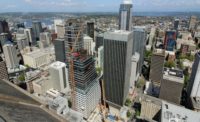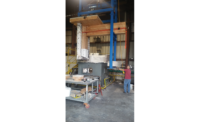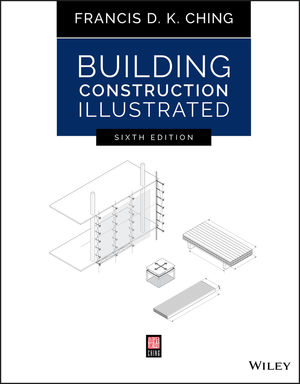Key Tests Say SpeedCore Needs No Fire Protection

Concrete fill of tied steel-plate panels carries much of the fire load.
PHOTO BY ATAOLLAH T. ANVARI, PURDUE UNIVERSITY
There is good news for boosters of a modular system of tied dual-plate walls field-filled with concrete—dubbed SpeedCore for its potential to slash superstructure construction time compared to steel frames with reinforced concrete cores. Pioneering fire tests show that the Lego-like system’s walls do not need costly fire protection, known to slow construction, especially inside elevator hoistways.
Walls 18 in. or thicker, with 3/8-in. or thicker plates, generally “do not need fire protection,” says Amit H. Varma, director of the Bowen Laboratory at Purdue University. Varma is principal investigator for the research that produced the 203-page report, Understanding Behavior and Performance under Fire Loading, published by Purdue’s Lyles School of Civil Engineering.
Test results arm engineers with concrete performance evidence to help convince owners, developers, architects and building officials that the unprotected SpeedCore system is safe under fire loading. “These walls are very difficult to fail” in fire tests because the concrete fill carries much of the fire load, says Varma.
At least one building official is convinced. “I would accept the tests and not require fire protection,” says Jon Siu, Seattle’s principal engineer-building official and a reviewer of the report, sponsored by $160,000 from the Charles Pankow Foundation, the Steel Institute of New York and the American Institute of Steel Construction (AISC).
Absent tests, Seattle did require fire protection on both sides of the 21-in.- to 45-in.-thick core walls, except for the inside wall adjacent to the hoistways, in Rainier Square Tower, SpeedCore’s 850-ft-tall proof of concept nearing completion downtown.
SpeedCore is the brainchild of recent ENR Award of Excellence winner Ron Klemencic, chairman and CEO of Magnusson Klemencic Associates. MKA engineered the Seattle tower. The Supreme Group prefabricated the modules. The Erection Co. Inc., led by its founder, CEO and 2019 ENR Newsmaker Adam Jones, erected the structure in only 10 months (ENR 1/20-27 p. 46).
MKA has five SpeedCore jobs in the works in California. “We have been pursuing the elimination of fireproofing on 200 Park Ave in San Jose, using the report as our reference,” says Klemencic. “It appears this will be accepted by the city.”
Design Guide Coming
Fire-loading design guidelines and specifications are coming as part of the free-to-download AISC Design Guide, expected out late this year or early next year.
All Pankow research products also are offered free. Though there have been 200 downloads of the report since its release in April and 400 downloads of design software that simulates fire-loading since its release late in May, SpeedCore is not catching on like wildfire.
Other engineers have proposed or shown interest in the system, but none have announced SpeedCore jobs.
“I think it is going to be a widely used system,” says Wally Ford, a structural engineer and principal with IMEG Corp. Ford proposed using SpeedCore for a 62-story mostly residential tower in Austin. But concrete was more competitive in speed and price. Undaunted, Ford plans to try again in a different market, where “concrete doesn’t have some of the advantages” it has in Texas.
For the tests, a SpeedCore specimen consisted of two structural steel plates held in place with cross-ties. Panels were filled with concrete. Five specimens with various plate slenderness ratios and applied load ratios were tested under combined axial and fire loading. Specimens had different parameters such as varied tie bar spacing, shear studs, loading ratios and fire scenarios.
The specimen had steel beams at either end, with half-cylindrical bearings, to allow rotation about the module’s weak axis. Instruments measured temperatures, strains and displacements.
Varma says the steel shell acts like a pressure cooker for the concrete. Vent holes, needed to place the concrete fill, are also needed to relieve the pressure as the concrete fill heats up.
More fire tests on different wall configurations—such as T- or C-shaped-in-plan walls—for more insights into SpeedCore’s behavior, are needed, says Varma.
Even so, test results to date are “wonderful,” says Brian Morgen, MKA’s project manager for Rainier Square Tower.






